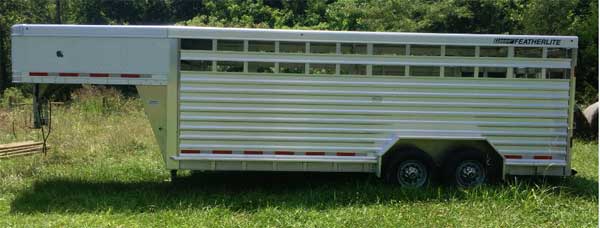A Brief Guide to Transporting and Hauling Bison
Ozark Valley Bison Ranch reserves the right to refuse to load bison in any trailer or carrier deemed unsafe or unsuitable for the purpose.
The safety of our bison is our top priority. Sorting and loading our animals requires careful planning and a strong commitment to safety.
Bison are not cattle and it's a lot different than just loading and hauling cattle. They are bigger, stronger, and more aggressive and can cause quite a bit of damage to you, themselves, and each other. Bison often panic when being sorted and pushed to load into a trailer – remember, bison are wild animals and you are a predator. It is no easy task - you need to be calm and cool about it.

Open sided trailers increase the stress level while being transported. If you have an open trailer, board up the sides. Solid walls are best and canvas roofs are a no-no.
Bison will move at full speed and strength most of the time. It is usually 40 mph going into the trailer and 40 mph coming off, when they want to. You need to know what you are doing and have an established plan. Bison have their own mindset. If they don't want to go, they're not going to go. You can't easily force them. It requires mitigating fear, managing anxiety, and allowing for an escape.
Just because they may be 200-400 pounds little calves, do not underestimate their strength, speed, and wildness.
The Trailer
A quality stock trailer is paramount. It should not be open on its sides and should have a solid roof, not canvas. Keep in mind that bison are wild animals, strong, and fast. Cheap trailers are not advisable.
The trailer should have solid walls about ¾ of the height of the trailer with the remaining height open for ventilation. The solid walls will help keep the animals stress level low. Open sided trailers increase the stress on the animals. When bison get stressed in confined quarters, they often take out their frustration aggressively on other bison resulting in injury.
If you have an open trailer, purchase some plywood and board-up the sides. If hauling calves, then 4 foot high would be adequate but older animals will require appropriately more height. To keep stress low, it is best if bison cannot see predators (humans) while trailered or transported.
Assuming an 8 foot wide trailer, you can generally haul one bison per every 2 feet of length. So, with a 20 foot trailer, you should be able to comfortably haul 10 bison. Just ensure that each bison has ample space to rest comfortably during the journey.
Depending on the sex, age, and temperament of the bison, they should be separated within the trailer. If at all possible, transport calves together, yearlings together, etc. This will minimize stress and their safety as older animals will often pick on the little ones.
Transporting
Unlike cattle, you can't just stop anywhere and hope for the best. It doesn't work that way with bison. You're risking the animals' welfare. While in motion, bison are generally more concerned with the motion, balance, noises, etc., than their anxiety and stress. But once you stop and those external stimuli are removed, their stress and anxiety may transfer into aggression. If you need to stop, listen carefully to how they respond and decide, based on their temperament, whether it is safe to leave them alone for any length of time.

We haul most of our bison in our 20 foot stock trailer with high solid walls. The bison cannot see out and there is no added stress from what's outside. This trailer has a slam gate – a worthwhile investment.
That also means you should plan on making the trip nonstop. While calves would probably be okay spending the night in the trailer with food and water, it would not be advisable with older animals. If a long trip, best to bring a partner to share in the driving and drive all night if necessary.
Keep in mind that animal "good-doers" are everywhere and bison hold a special place for many. If you ever need to leave your trailer and bison alone for any length of time, be sure to have padlocks on every single door. Do not allow anyone the opportunity to "set them free".
Last but not least, drive safely and smoothly. No sharp turns, no hard stops, or fast acceleration. If a bison loses its balance in the trailer and falls, it will create a panic and the fallen bison is likely to get trampled and injured and sometimes killed. While transporting 8 bison bulls to market, in order to avoid an accident we were forced to slam on the brakes. The result was 2 dead bison and one so severely bruised the meat was discarded. Those 3 bison were trampled to death.
Take your time and drive safely.
Ozark Valley Bison Ranch LLC
Fox, AR
